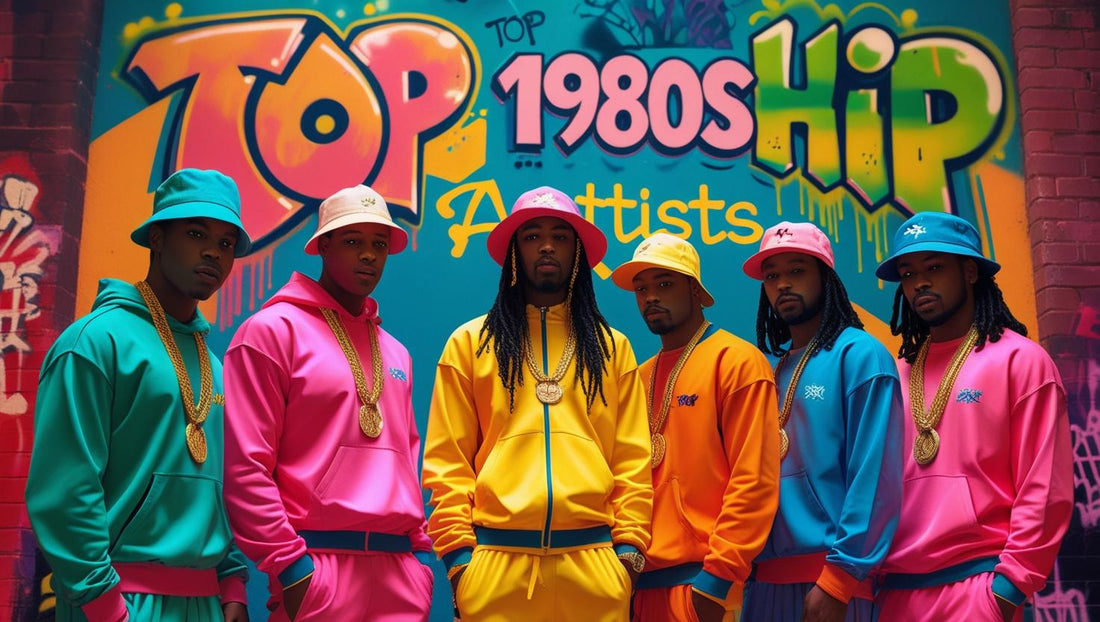Top 1980s Hip Hop Artists Who Defined a Generation

Top 1980s Hip Hop Artists Who Defined a Generation
The 1980s marked the golden era of hip hop a period of explosive creativity, bold innovation, and cultural transformation. It was during this decade that many of the most influential hip hop artists emerged, shaping not only the sound of a genre but the voice of a generation. From the raw energy of street cyphers to the polished presence on national television, the 1980s hip hop artists helped define what would become a global movement.
This guide explores the top 1980s hip hop artists who laid the foundation for modern rap, production, and hip hop culture. Their influence still echoes in today's beats, rhymes, and visuals.
Pioneers of 1980s Hip Hop
Grandmaster Flash & The Furious Five
Grandmaster Flash was a technical pioneer who elevated DJing into an artform. His innovations in turntablism such as backspins and punch phrasing set the stage for hip hop’s sonic identity. With the Furious Five, he delivered "The Message," a breakthrough track that brought social commentary into rap, making hip hop a tool for activism and awareness.
Kurtis Blow
Kurtis Blow was the first rapper signed to a major label and the first to achieve gold status. His hits like “The Breaks” brought hip hop to a national audience and helped bridge the underground scene with mainstream appeal.
Run-D.M.C.
Run-D.M.C. introduced a harder, stripped-down style that changed the sound of rap. Their fusion of hip hop and rock, especially with the hit “Walk This Way” alongside Aerosmith, broke genre barriers. Their style Adidas tracksuits, hats, and minimalistic beats became iconic and influenced hip hop fashion and branding for decades.
LL Cool J
LL Cool J brought charisma, versatility, and mass appeal to solo rap performance. He blended battle-ready bravado with emotional ballads like “I Need Love,” proving that hip hop could be both tough and tender. LL became one of Def Jam’s first breakout stars and a blueprint for long-term success in music and media.
Lyrical Legends and Conscious Voices
Boogie Down Productions
Led by KRS-One, Boogie Down Productions made knowledge and activism central themes in hip hop. Their album “Criminal Minded” brought aggressive beats and raw street realism, while later works introduced education and philosophy into the mix.
Public Enemy
Public Enemy used hip hop as a platform for political expression. Fronted by Chuck D and Flavor Flav, and produced by The Bomb Squad, their dense, sample-heavy sound supported messages about institutional racism, surveillance, and Black empowerment. Albums like “It Takes a Nation of Millions to Hold Us Back” remain classics of protest music.
Juice Crew
The Juice Crew, based in Queensbridge and led by producer Marley Marl, featured MCs like Big Daddy Kane, Kool G Rap, Roxanne Shanté, Biz Markie, and MC Shan. Known for complex lyricism and fierce wordplay, they raised the bar for rap as an artform and fueled one of hip hop’s first major beefs: the Bridge Wars.
Ice-T
Ice-T helped define West Coast rap with gritty street tales and uncompromising lyrics. His early work laid the groundwork for gangsta rap and positioned hip hop as a mirror of real-life urban struggles. Ice-T’s crossover into acting and television later helped push hip hop deeper into mainstream culture.
Slick Rick
Slick Rick stands as one of the most iconic figures in hip hop history and is widely celebrated as the greatest storyteller in rap. His 1988 debut album The Great Adventures of Slick Rick delivered vivid, narrative-driven songs that captivated listeners with humor, wit, and unforgettable characters. Tracks like “Children’s Story” and “Mona Lisa” are still considered gold standards in hip hop storytelling.
With his smooth British-American accent, animated delivery, and detailed imagery, Slick Rick introduced a theatrical dimension to rap that was both innovative and enduring. He proved that
hip hop could be as much about narrative and character as it was about bravado and punchlines.
Slick Rick’s influence can be heard in generations of artists who followed, including Nas, Snoop Dogg, and J. Cole. His impact on the art of lyrical storytelling remains unmatched.
Regional Pioneers and Trailblazers
2 Live Crew
Based in Miami, 2 Live Crew became infamous for their explicit lyrics and legal battles over censorship. Despite controversy, they championed freedom of speech and brought Southern bass-heavy production to national attention, paving the way for the Miami hip hop scene.
Geto Boys
Hailing from Houston, the Geto Boys brought psychological depth and Southern grit to their music. Their breakout hit “Mind Playing Tricks on Me” combined vivid storytelling with reflections on trauma, mental health, and street violence, establishing Southern rap as a formidable force.
N.W.A.
N.W.A. shook the industry with aggressive delivery and unfiltered depictions of life in Compton. “Straight Outta Compton” introduced Dr. Dre, Ice Cube, and Eazy-E to the world, sparking both mainstream backlash and critical acclaim. Their unapologetic stance made them legends and helped define West Coast hip hop.
Women Who Shaped the Genre
MC Lyte
One of the first solo female rappers to release a full-length album, MC Lyte brought sharp lyricism and poise to a male-dominated scene. Her tracks like “Paper Thin” and “Lyte as a Rock” proved that skill, not gender, defined a true MC.
Salt-N-Pepa
Salt-N-Pepa, along with DJ Spinderella, were trailblazers for female empowerment in hip hop. Songs like “Push It” and “Let’s Talk About Sex” mixed commercial appeal with messages about independence and confidence.
Queen Latifah
Queen Latifah emerged as a force of nature in hip hop, blending Afrocentric pride, feminism, and jazz-infused beats. Her anthem “Ladies First” and debut album All Hail the Queen opened doors for socially conscious female voices in rap.
Roxanne Shanté
As a teenager, Roxanne Shanté ignited the “Roxanne Wars” with a fearless diss track response to UTFO’s hit. She quickly gained respect for her sharp freestyle abilities and became one of the first female MCs to command attention in battle rap.
Eclectic Artists and Sound Innovators
Whodini
Whodini fused hip hop with R&B-style hooks and storytelling. Their hits “Friends” and “Freaks Come Out at Night” offered a polished, melodic approach that helped broaden hip hop’s appeal in clubs and on radio.
UTFO
UTFO’s track “Roxanne, Roxanne” sparked one of the largest response-record feuds in hip hop history. The group’s storytelling and stage presence made them memorable figures in the genre’s early crossover into pop markets.
EPMD
EPMD specialized in funk-based beats and smooth flows. Their name “Erick and Parrish Making Dollars”—reflected their business-savvy approach to music. With tracks like “You Gots to Chill,” they helped solidify the East Coast’s signature boom-bap sound.
Eric B. & Rakim
Eric B. & Rakim transformed hip hop in the late 1980s by setting a new standard for lyricism and production. Their debut album Paid in Full (1987) introduced Rakim’s revolutionary flow—marked by internal rhymes, complex bars, and a calm, confident delivery. His lyrical precision shifted the way MCs approached writing and performance, earning him the reputation as one of the greatest rappers of all time.
Eric B.’s production paired Rakim’s intricate verses with soulful, sample-heavy beats, creating a sound that was refined, head-nodding, and unmistakably East Coast. Together, they pushed hip hop into a more mature and intellectual space, influencing a generation of lyricists and producers alike.
Their legacy is felt in artists ranging from Nas and Wu-Tang Clan to Kendrick Lamar. Eric B. & Rakim weren’t just influential—they changed the DNA of hip hop.
Beastie Boys
The Beastie Boys brought a unique blend of punk rebellion and hip hop rhythm. Their debut album Licensed to Ill became the first rap album to reach number one on the Billboard 200. Their later work showcased experimental production and live instrumentation, making them one of the most influential groups in genre fusion.
Lasting Impact of 1980s Hip Hop Artists
The contributions of 1980s hip hop artists extend far beyond their era. Their influence is embedded in today’s music, fashion, social movements, and media. The innovations in sampling, lyricism, DJing, and storytelling they introduced remain cornerstones of hip hop culture.
Contemporary artists frequently sample or reference 1980s hip hop tracks. Producers still mimic the techniques developed with SP-1200s, MPCs, and early drum machines. Lyrical formats, rhyme patterns, and even stage performances today owe a great deal to this era’s pioneers.
Conclusion: Why 1980s Hip Hop Artists Still Matter
The 1980s was not just a decade of growth—it was the genesis of hip hop as a cultural force. The artists who defined this era turned local talent into global influence, grassroots movements into international industries. They crafted the blueprint for generations of rappers, DJs, and producers to come.
To study the 1980s hip hop artists is to understand the roots of one of the most powerful art forms in the world. Their music wasn’t just entertainment; it was history, commentary, and revolution on wax.
No comments









0 comments